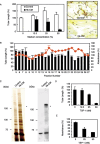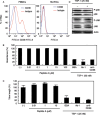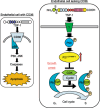Novel antiangiogenic pathway of thrombospondin-1 mediated by suppression of the cell cycle
- PMID: 17596205
- PMCID: PMC11159057
- DOI: 10.1111/j.1349-7006.2007.00534.x
Novel antiangiogenic pathway of thrombospondin-1 mediated by suppression of the cell cycle
Abstract
We have recently reported that keratin 14-promoter-driven vascular endothelial growth factor (VEGF)-E(NZ-7) transgenic mice have a significant number of capillary vessels in subcutaneous tissue. However, these vessels are generated in a layer some distance from the epithelial basal cells that express VEGF-E(NZ-7), suggesting that one or more antiangiogenenic molecules may exist very near the basal cell layer. By screening keratinocyte-conditioned medium, we found that thrombospondin-1 (TSP-1) is produced from keratinocytes and suppresses human umbilical vein endothelial cells (HUVEC) growth as well as tubular formation in a HUVEC-fibroblast coculture system. Different to the known mechanism of CD36-dependent endothelial cell apoptosis, the HUVEC we used did not express CD36 at detectable levels, indicating a new mechanism for TSP-1-induced antiangiogenesis. We found that TSP-1 induces little apoptosis of endothelial cells but causes cell-cycle arrest, increasing the amounts of p21(CIP/WAF-1) and unphosphorylated retinoblastoma (Rb) in HUVEC. CD36-binding peptide in TSP-1 and CD36-neutralizing antibody did not block the TSP-1-induced cell-cycle arrest. Our results strongly suggest that TSP-1 utilizes a novel pathway for its antiangiogenic effect independent of CD36, and suppresses the cell cycle.
Figures





Similar articles
-
Identification of CD36 molecular features required for its in vitro angiostatic activity.FASEB J. 2005 Oct;19(12):1713-5. doi: 10.1096/fj.05-3697fje. Epub 2005 Jul 21. FASEB J. 2005. PMID: 16037098
-
Molecular basis for the regulation of angiogenesis by thrombospondin-1 and -2.Cold Spring Harb Perspect Med. 2012 May;2(5):a006627. doi: 10.1101/cshperspect.a006627. Cold Spring Harb Perspect Med. 2012. PMID: 22553494 Free PMC article. Review.
-
CD36-mediated activation of endothelial cell apoptosis by an N-terminal recombinant fragment of thrombospondin-2 inhibits breast cancer growth and metastasis in vivo.Breast Cancer Res Treat. 2011 Jul;128(2):337-46. doi: 10.1007/s10549-010-1085-7. Epub 2010 Aug 17. Breast Cancer Res Treat. 2011. PMID: 20714802 Free PMC article.
-
Capillary sprout endothelial cells exhibit a CD36 low phenotype: regulation by shear stress and vascular endothelial growth factor-induced mechanism for attenuating anti-proliferative thrombospondin-1 signaling.Am J Pathol. 2008 Oct;173(4):1220-8. doi: 10.2353/ajpath.2008.071194. Epub 2008 Sep 4. Am J Pathol. 2008. PMID: 18772338 Free PMC article.
-
CD36: a critical anti-angiogenic receptor.Front Biosci. 2003 Sep 1;8:s874-82. doi: 10.2741/1168. Front Biosci. 2003. PMID: 12957861 Review.
Cited by
-
Genomic and proteomic analysis of the impact of mitotic quiescence on the engraftment of human CD34+ cells.PLoS One. 2011 Mar 7;6(3):e17498. doi: 10.1371/journal.pone.0017498. PLoS One. 2011. PMID: 21408179 Free PMC article.
-
Endothelial SRF/MRTF ablation causes vascular disease phenotypes in murine retinae.J Clin Invest. 2013 May;123(5):2193-206. doi: 10.1172/JCI64201. Epub 2013 Apr 8. J Clin Invest. 2013. PMID: 23563308 Free PMC article.
-
Potential Biomarkers to Predict Acute Ischemic Stroke in Type 2 Diabetes.Front Mol Biosci. 2021 Dec 1;8:744459. doi: 10.3389/fmolb.2021.744459. eCollection 2021. Front Mol Biosci. 2021. PMID: 34926573 Free PMC article.
-
TSP-1 is downregulated and inversely correlates with miR-449c expression in Cushing's disease.J Cell Mol Med. 2019 Jun;23(6):4097-4110. doi: 10.1111/jcmm.14297. Epub 2019 Apr 23. J Cell Mol Med. 2019. PMID: 31016850 Free PMC article.
-
Proteome-wide analysis reveals an age-associated cellular phenotype of in situ aged human fibroblasts.Aging (Albany NY). 2014 Oct;6(10):856-78. doi: 10.18632/aging.100698. Aging (Albany NY). 2014. PMID: 25411231 Free PMC article.
References
-
- Folkman J. Tumor angiogenesis: therapeutic implications. N Eng J Med 1991; 285: 1182–6. - PubMed
-
- Hanahan D, Folkman J. Patterns and emerging mechanisms of the angiogenic switch during tumorigenesis. Cell 1996; 86: 353–64. - PubMed
-
- Risau W. Mechanisms of angiogenesis. Nature 1997; 386: 671–4. - PubMed
-
- Kiba A, Sagara H, Hara T, Shibuya M. VEGFR‐2‐specific ligand VEGF‐E induces non‐edematous hyper‐vascularization in mice. Biochem Biophys Res Commun 2003; 301: 371–7. - PubMed
-
- Folkman J. Endogenous angiogenesis inhibitors. APMIS 2004; 112: 496–507. - PubMed
Publication types
MeSH terms
Substances
LinkOut - more resources
Full Text Sources
Molecular Biology Databases
Miscellaneous

